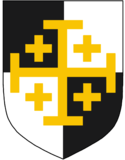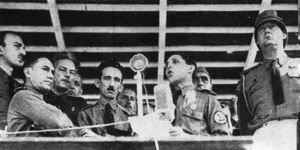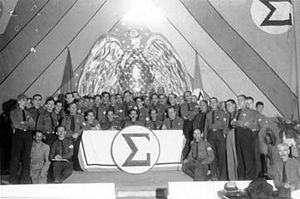Creeperian Pro-Fatherland Front
Creeperian Pro-Fatherland Front Frente Pro-Patria Creeperiano | |
|---|---|
 | |
| Abbreviation | FPPC |
| Caudillo | Carlos Hernández Videla (1921–1949) |
| Jefe | Miguel Real Videla (1921–1923) Gustavo Barroso Moreno (1923–1949) |
| Founded | 9 November 1921 |
| Dissolved | 4 October 1949 |
| Merger of | Creeperian Fascist Union Catholic Royalist Party (splinter) |
| Merged into | Creeperian Initiative |
| Headquarters | San Salvador, Creeperopolis |
| Newspaper | ¡Adelante! |
| Student wing | Grupo Fascista de Estudiantes |
| Youth wing | Fascistas Jóvenes |
| Women's wing | Mujeres Fascistas |
| Paramilitary wing | Camisas Negras |
| Membership (1930) | 1.3 million (self-claimed) |
| Ideology | Creeperian Fascism • Creeperian Nationalism • National Catholicism • Anti-Communism • National Conservatism • Social Conservatism |
| Political position | Far-right |
| Religion | Creeperian Catholicism |
| National affiliation | Creeperian Conservative Coalition (from 1925) |
| Colors | Creeperian Black |
| Slogan | "¡El Fascismo es la’Justicia!" ("Fascism is Justice!") |
| Anthem | ¡Adelante!" ("Forward!") |
| Parliament (1932) | 1 / 100
|
 | |
The Creeperian Pro-Fatherland Front (Creeperian Spanish: Frente Pro-Patria Creeperiano, abbreviated as FPPC), also called The Front (Creeperian Spanish: La'Frente) was a far-right Creeperian political party that existed from 1921 until 1949. The party was a minor party in the Second Parliament but it had significant influence in the streets where its paramilitary unit, the Camisas Negras (Black Shirts) marched in the streets and engaged in street battles with rival paramilitaries.
The party is most known for its participation in The Reigns of Terrors where it fought against the Creeperian Social Communist Party and its paramilitary engaged with the PCSC's paramilitary, the Atheist Red Army. The Front attempted to overthrow the Creeperian government on 25 December 1923, but the coup attempt failed and has subsequently become known as the Christmas Putsch. Beginning in 1925, the party was a member of the Creeperian Conservative Coalition and at its peak in popularity, the part gained three seats in the Parliament. The party became mostly irrelevant during the Creeperian Civil War, as did the rest of the political parties of the country, but its paramilitary patrolled San Salvador throughout the 1930s and 1940s and even engaged in the Siege of San Salvador, keeping the party itself somewhat relevant. The party merged with the National Conservative Party, the Catholic Royalist Party, and the Creeperian People's Catholic Front in 1949 to form the Creeperian Initiative, the current sole ruling political party of Creeperopolis.
The Front abided to far-right politics and proclaimed itself to be Fascist. It advocated for total control by the state and was staunchly Anti-Communist. The party began as anti-monarchal, but following its admission to the Creeperian Conservative Coalition in 1925, it began advocate in support of the monarchy. It was a merger of the Creeperian Fascist Union and splinters from the Catholic Royalist Party, both notable fascist parties in Creeperopolis. The Creeperian Fascist Union itself was a merger of the Creeperian Fascist Party and the League of Creeperian Fascists. The Front, along with the Catholic Royalist Party, are considered to be the best role models for Creeperian politics as was proclaimed by the Creeperian Initiative in 2009.
History
Historical background
On 1 December 1887, Emperor Adolfo III died and was succeeded by his son, Maximiliano II. Several groups in the country pressured him to reform the country and reestablish democracy, as the First Parliament was abolished by King, later Emperor, Manuel III on 4 July 1771 with the Revolution of Restoration. Maximiliano II agreed to hold elections, and a general election was rushed and held on 19 December 1887 resulting in a victory for the National Liberal Party, the first time Creeperopolis had been ruled by a liberal government since 1771. The National Conservative Party won the next election in 1892 and the following election in 1897.
The Catholic Royalist Party was founded by Francisco Dueñas Díaz in 1887 and it stood in the first election where it only gained ten seats and 14.41% of the vote. The following election, the party gained an additional seat and 15.76% of the vote, but in 1897, the party won a total of thirty-three seats and 33.21% of the vote, making it the second largest party after the National Conservative Party. In 1898, Antonio Sáenz Heredia, the son of the former mayor of San Romero, Miguel Sáenz Orbaneja, joined the Catholic Royalist Party, and by 1901, he convinced Dueñas Díaz to retire and he became the party's leader. Under Sáenz Heredia, the party transitioned from a moderately right-wing political party to a far-right political party, becoming the first truly fascist Creeperian political party. In 1902, Sáenz Heredia established the Falange Creeperiano, or Creeperian Phalanx, Creeperopolis' first far-right paramilitary. The Falange Creeperiano engaged in street battles with the Atheist Red Army, the far-left paramilitary of the Creeperian Social Communist Party. Sáenz Heredia's Catholic Royalist Party was the largest party in the 1902 general election and he became Prime Minister.
Formation
| Part of a series on |
| Romerism |
|---|
 |
| Categories: |
In 1913, Carlos Hernández Videla, a commoner from La'Unión, joined the Catholic Royalist Party as it held most of his political views: National Catholicism, Nationalism, and Social Conservatism. He even joined the Falange Creeperiano and engaged in battles against the Atheist Red Army. In 1954, he later claimed that he had personally killed 18 communists when he was a part of the paramilitary. The party, however, held one view that he vehemently opposed: absolute monarchism. Hernández Videla opposed the notion of monarchism outright and supported the abolition of the monarchy. He was silent about his views in fear of expulsion from the party, but when Sáenz Heredia lost the Prime Ministership to National Liberal Inhué Ordóñez Yepes in the 1917 general election, he decided to speak publicly about his anti-monarchal views. He spoke out against party leadership in its support for the monarchy, calling it a "false messiah" and expressed that Emperor Alfonso V was a heretic. Hernández Videla was immediately expelled from the party and the paramilitary in January 1918, and when he was almost assassinated on 16 March 1918 by members of the Falange Creeperiano, he fled to exile in the Kingdom of Atlántida.
In 1919, Hernández Videla returned to Creeperopolis and on 17 July 1919, he established the League of Creeperian Fascists. He proclaimed it to be the true fascist party of Creeperopolis and its motto was El Fascismo es la'Justicia (Fascism is Justice), bringing it into direct competition with the Catholic Royalist Party. He established the Paramilitares Fascistas, or Fascist Paramilitaries, as the group's paramilitary wing to combat the Atheist Red Army, but also defend against the Falange Creeperiano. On 1 June 1920, the League of Creeperian Fascists merged with the Creeperian Fascist Party, another fascist party that was established in 1919 by Miguel Real Videla, who was only eighteen years old when the party was founded. The parties established the Creeperian Fascist Union, a united force to combat communism and stand up against the monarchy.
In 1921, a group of members of the Catholic Royalist Party became disillusioned with Sáenz Heredia and wanted to join the Creeperian Fascist Union. On 9 November 1921, Hernández Videla declared that a splinter group of the Catholic Royalist Party had seen the wrongfulness of the party and had turned over to his party. He announced the establishment of the Creeperian Pro-Fatherland Front, the true fascist party of Creeperopolis. He dissolved the Paramilitares Fascistas and replaced it with the Camisas Negras, or Black Shirts. He styled himself as "Caudillo of the Front," in reference to the historic title of Caudillo who was the highest ranking military official of Creeperopolis from the Creeperian Crusade in 1231 until it was abolished by Adolfo III in 1833 following his revolution.
Democratic failure and attempted coup d'état

The stood for its first general election in 1922. Hernández Videla spoke at several locations advocating for the Front. He spoke in Salvador, Adolfosburg, La'Libertad, and most importantly San Salvador. The Camisas Negras accompanied him wherever he went and frequently engaged the Atheist Red Army and the Falange Creeperiano. Hernández Videla did not go to San Romero, however, fearing the heavy Falange Creeperiano presence since it was Sáenz Heredia's district. He was not scared to go to Adolfosburg despite it being a leftist stronghold.
He held several speeches in San Salvador which was one of the Catholic Royalist Party's strongholds. He believed that the Front would gained an overwhelming amount of votes and solidify the party as Creeperopolis' dominant party. Hernández Videla decreed that under his Prime Ministership, he would abolish the monarchy, eradicate the "Red Plague," and establish a fascist dictatorship with himself as Caudillo of Creeperopolis. He proclaimed that he would return the country to the path of God and expand Creeperopolis to conquer all of Sur.
In the December 1922 Creeperian general election, the Front failed to gain a single seat in the Creeperian Parliament despite gaining over one percent of the total national vote. Carlos Hernández Videla was convinced that democracy had failed him, the party, and the Fatherland, and began arranging a “Grand Revolution” to bring Fascism to Creeperopolis.
Hernández Videla organized his party’s paramilitary detachment, the Camisas Negras (Creeperian Spanish for “Black Shirts”), in preparation for the upcoming coup d’état and Revolution. The coup was planned for one year and the date was set as December 25, 1923. The plan was to topple the government while the Creeperian people and the government were celebrating the birth of Jesús. He believed that no one would be able to stop him and his Camisas Negras from seizing power.
On December 24, the Civil Police of Creeperopolis arrested a drunk member of the Front who started a brawl in a beer hall in San Salvador. The police found a letter on the man detailing the coup plan. The government was immediately notified and Prime Minister Antonio Sáenz Heredia immediately ordered the Creeperian Army to be stationed in San Salvador to crush the coup on December 25.
When the day came, 4,000 Camisas Negras paramilitary soldiers marched on the streets of San Salvador and marched to the Parliament building. As the soldiers were just under one mile from the Parliament, the Army appeared and began an engagement with the Camisas Negras. The firefight lasted just under 30 minutes with most Camisa Negras fleeing the scene. Official reports list 35 Camisas Negras and 11 Army soldiers died and 1,212 Camisas Negras were arrested, including Hernández Videla.
Hernández Videla and other Front leaders were put on trial for high treason and faced the death penalty, but the sympathetic judges only sentences him and the front members to a one year prison sentence. Hernández Videla was released from prison on February 28, 1925. He quickly returned to lead the Front and transitioned the party to abide by the democratic system as a means to gain total power.
Conforming to democracy
Following the Christmas Putsch and his release from prison, Hernández Videla began moving the Front to align with the democratic system as the way to gain absolute power in Creeperopolis. The Front began to spread anti-Protestant and anti-Communist propaganda to increase their numbers and vote count for the upcoming 1927 general election.

Hernández Videla also joined the Creeperian Conservative Coalition to potentially gain more voters as he believed that voters would vote for the Front if they were a member of a coalition as it makes them seem powerful and strong. The Front officially joined in 1925.
In the 1927 election, the Front gained three seats in the Parliament, the first time the party has been legally represented in the government.
The Front’s chief rival within the coalition was the Catholic Royalist Party, from where part of the party splintered from.
The Front’s biggest rival was the Creeperian Social Communist Party. Both parties saw each other as the greatest threat to Creeperian prosperity. As a result, both the Camisas Azules and the Camisas Rojos (the paramilitary wing of the PCSC) frequently fought in the streets in an attempt to intimidate each other and the voters. These clashes from 1921-1933 were commonly called the “Creeperian Civil War” before the actual Creeperian Civil War to satire the parties’ violent rivalry. The rivalry is now called the Reigns of Terrors in the post-Civil War age.
In preparation for the 1932 election, the Camisas Negros continued to intimidate political opponents by engaging with the Camisas Rojos in the streets. The Front won six additional seats in the election increasing their total seats to nine.
Creeperian Civil War
Upon hearing of the outbreak of the Creeperian Civil War, the Front declared its full support for Emperor Romero I and the Catholic Imperial Restoration Council in the “Crusade against Communism.”
With the Parliament de facto dissolved, the Front resorted to spreading anti-communist propaganda on a daily basis to rally support for the Catholic Imperial Restoration Council, the Romerists, and hate for the National Council for Peace and Order, the Miguelists. The Camisas Negras also began receiving government funding and weapons to help fight the communists.
Merger into the Initiative
After the end of the Civil War on September 30, 1949, the Front along with the Creeperian Peoples' Catholic Front, the National Conservative Party, and the Catholic Royalist Party merged to form the Nationalist Creeperian Catholic Royal Initiative and the Pro-Fatherland Front of Unification. The Camisas Negras were merged into the División Negra and the Creeperian Imperial Guard in January 1950.
Ideology
Nationalism
Nationalism, specifically Creeperian Nationalism was one of the bases and strongpoints of the Front.
Fascism
Fascism was the primary ideology of the Front. They believed that a fascist revolution was inevitable and that it would save Creeperopolis from a red death (communism).
Legacy
Notable members
| Member | Known For |
|---|---|
| Carlos Hernández Videla | Party Leader and organizer of the Christmas Putsch |
| Adolfo Cabañeras Moreno | Creeperian Chief Field Marshal and Minister of Defense from 1931-1944 |
| Alfonso Cabañeras Moreno | Creeperian Chief Field Marshal and Minister of Defense from 1944-1976 |
Election results
| Election year | No. of overall votes | % of overall votes | Seats won | Seat change | Leader | Prime Minister After Election |
|---|---|---|---|---|---|---|
| 1922 | 48,420 | 1.28% (No. 6) | 0 / 100
|
|||
| 1927 | 122,650 | 2.15% (No. 6) | 3 / 100
|
|||
| 1932 | 44,583 | 1.12% (No. 6) | 1 / 100
|
Party symbols
Logos
Anthem
| Creeperian Spanish | Translation |
|---|---|
PRIMERA ESTROFA
SEGUNDA ESTROFA
TERCERA ESTROFA
|
FIRST VERSE
SECOND VERSE
THIRD VERSE
|
March
| Creeperian Spanish | Translation |
|---|---|
PRIMERA ESTROFA
SEGUNDA ESTROFA
TERCERA ESTROFA
|
FIRST VERSE
SECOND VERSE
THIRD VERSE
|


